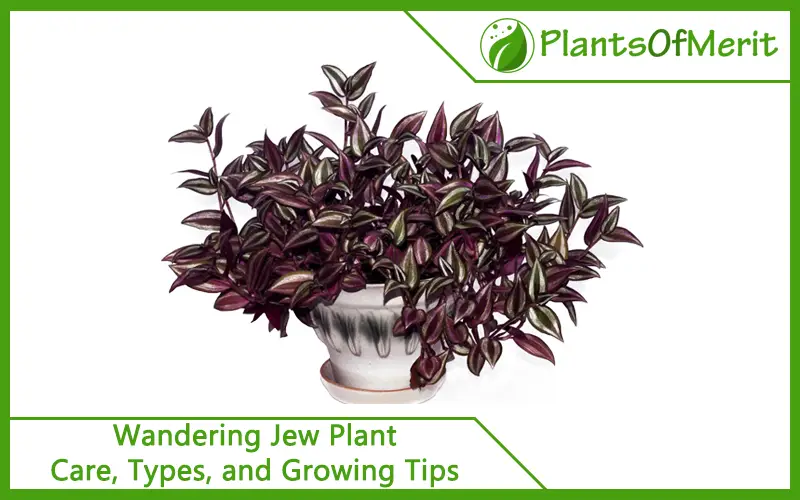Growing plants in your yard or your patio is not just a hobby but enables you to explore different species and varieties of plants. Wandering Jew is one such option. Surprisingly enough, it is not a single plant. Instead, it includes a variety of different types of plants belonging to the genus Tradescantia.
Despite what you know about the fundamentals of growing a Wandering Jew, let us clarify that it’s quite a complicated process. There are certain sensitive parameters that the plant needs for optimal growth.
Accumulating all the information available, we have finally compiled a comprehensive article that explains everything about a Wandering Jew plant, its types, and growing tips.
Wandering Jew – Overview
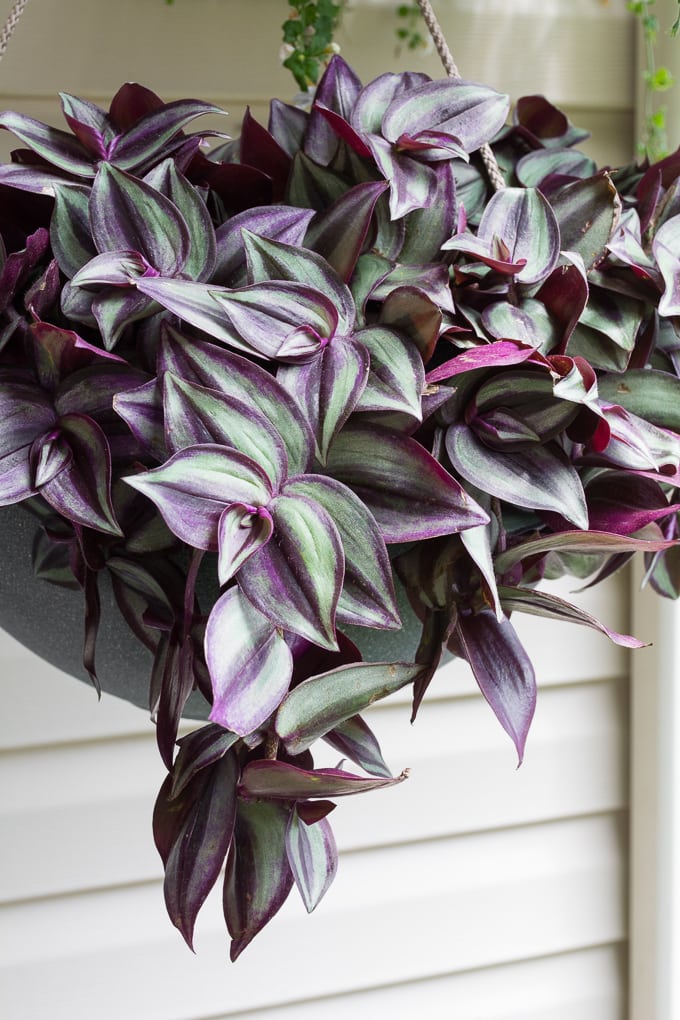
Before delving into the depths of this plant, let us walk you through the basics. Having this table handy will make it easier for you to grow the plant while maintaining optimal temperature parameters.
Here’s what you need to know:
| Characteristics | Details |
| Common name | Wandering jew, Inch plant |
| Scientific name | Tradescantia zebrina, Tradescantia fluminensis |
| Origin | Mexico |
| Family | Commelinaceae |
| Temperature | 50-80°F |
| Height | Up to 6 feet |
| Light | Indirect sunlight |
| Water | Average |
| Humidity | Average |
| Soil | Slightly moist |
| Propagation | Cuttings |
| Pests | Root rot, Aphids, Spider mites, etc. |
When it comes to the appearance, the Wandering Jew generally keeps changing concerning the type you are planting. The standard one has bright green, heart-shaped leaves with purple stripes that stand out from the rest of the plants in the garden.
If you are worried about whether a Wandering Jew is a flowering plant or not, it is. The flowers are made of three petals and are generally white or purple.
What are the Types of Wandering Jew plants?
As we said before, Wandering Jews are categorized into a few other types. The term, Wandering Jew is primarily used as an umbrella term and all the types belong to the Tradescantia genus. They do differ slightly in the overall appearance and characteristics, so you need to be mindful of that as well.
There are three primary types of Wandering Jew plants that we will be discussing in this article:
1. Tradescantia fluminensis
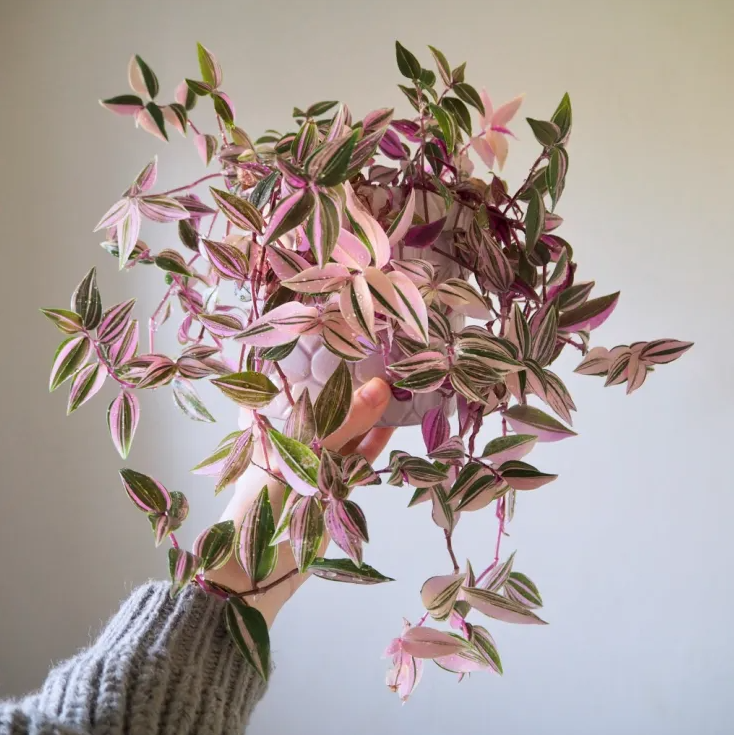
When it comes to discussing a Wandering Jew, the Tradescantia fluminensis is the standard or the most common one that people discuss. It is readily available and features the standard combination of bright green-colored leaves and stark white flowers. The three-petal flowers also have yellow pistils inside, which adds to the overall look of the plant from afar.
2. Tradescantia zebrine
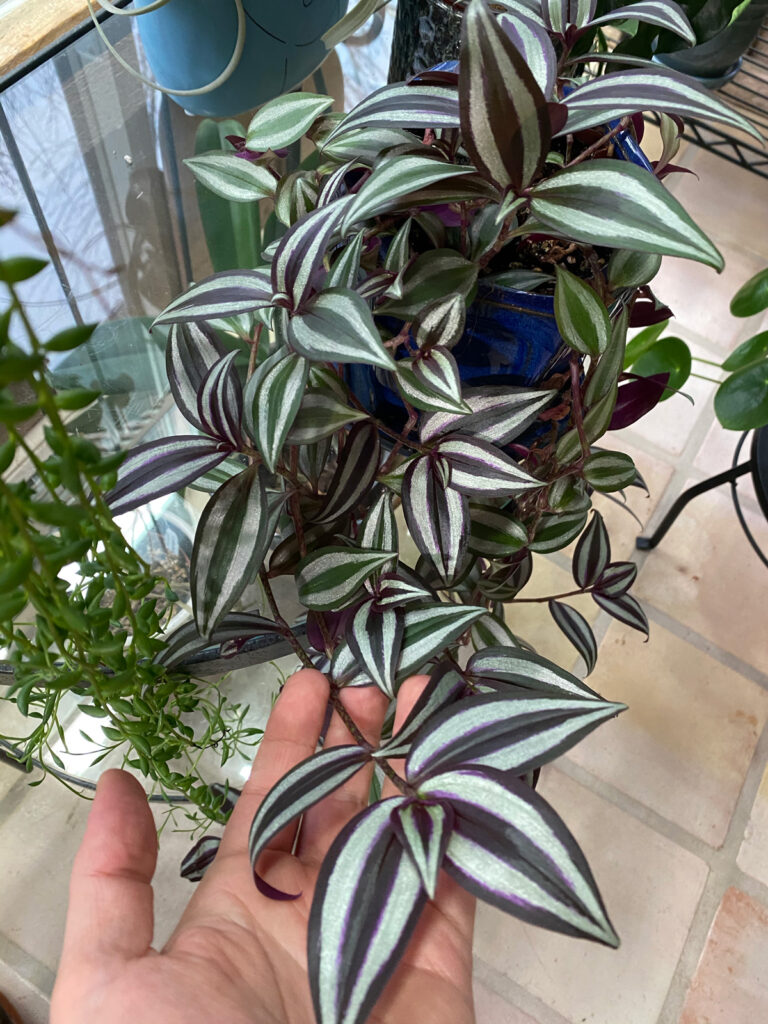
The next on the list is the Tradescantia zebrina, which is available in certain parts of the world. As the name suggests, the plant has a striped appearance, much like what you’d notice in a zebra. The majority of the leaves are dark green with white and purple stripes running down the leaves in a vertical motion. The outer edges of the leaves have a very shiny silver appearance, which adds to the uniqueness of this type of Wandering Jew.
3. Tradescantia pallida
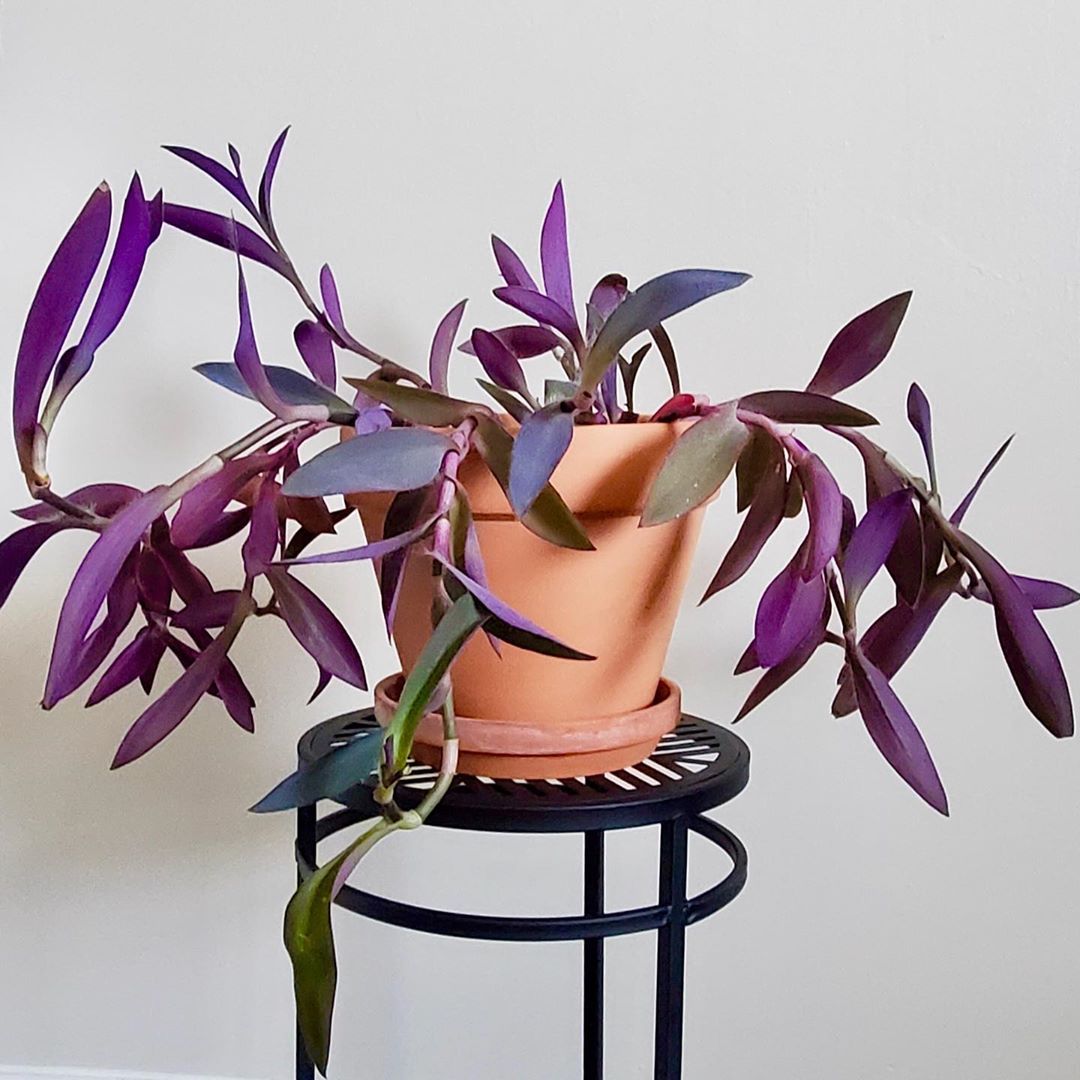
Last on the list of types is the Tradescantia pallida. This one is unlike the other two that you have available. Instead of sporting bright green foliage, the leaves are bright purple, which makes it one of the most unique kinds of wandering jew plants you will come across in the market. Besides the purple leaves, even the flowers are a light shade of purple, making a bright contrast against the other plants in your garden.
Besides these, there are a few other types of Wandering Jew Plants, including:
- Bolivian
- Bridal veil
- Red burgundy
- Purple fuzzy leaves
- Green fuzzy leaves
- Purple queen
Which type of Wandering Jew you consider purchasing depends on the kind of area or country you live in, the temperature, and the availability of the correct parameters to support the plant’s growth.
More about Wandering Jews
If you are completely clueless about Wandering Jews, let us give you a quick rundown of the fundamentals. Wandering Jews are tropical plant that hails from the native areas of Mexico. This is one of the reasons why it thrives in slightly warmer and sunny climates.
Also, they are tender perennials and are often sold as annual plants for plantations in colder countries. Irrespective of the type of Wandering Jew plant you buy, all of them more or less require the same care and parameters to grow at a substantial rate.
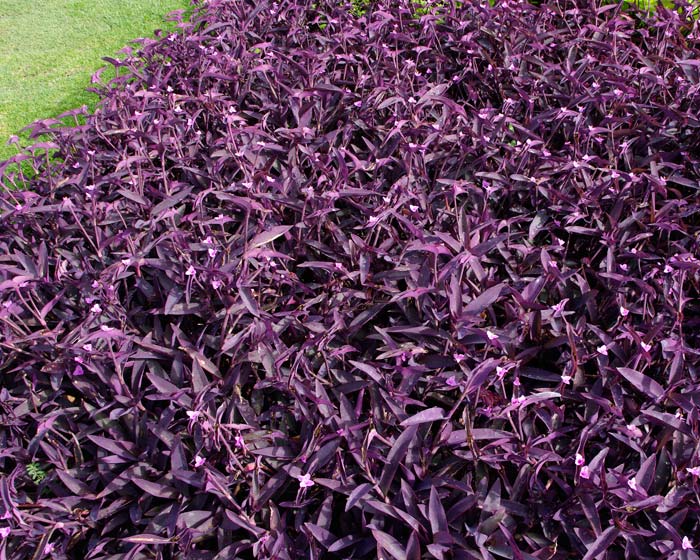
For the first-time growers who are afraid of killing the plant due to lack of proper care, don’t worry. Despite their appearance, Wandering Jew plants are quite hardy. Even with the changes to their standard parameters, the plant can sustain itself and won’t die on you.
However, the only thing that you need to monitor closely is the temperature. They don’t do well in extremely cold temperatures. So, if you live in areas where it gets cold easily, we’d recommend either avoiding planting them outside or growing them in an indoor setting with the right parameters.
Where should I grow Wandering Jews?
Before we delve into the Wandering Jews plant care, we’d recommend that you first sort out the place where you will grow them. Is it better to grow the plant indoors? Should you grow it outdoors?
The question is quite intriguing, so let us explore more on that.
- Growing outdoors
Since Wandering Jew plants depend on bright and indirect sunlight for optimal growth, growing them outdoor is your ideal choice. This ensures effective growth in the long run, especially if you plant them during the bright, summer season.
However, ensure that you grow them in pots instead of digging them and planting them into the soil directly. Growing them in individual pots ensures that you can move them safely whenever needed. Also, having a pot supports the growth of the creepers and vines when you provide the support.
- Growing indoors
As we said before, Wandering Jews can’t withstand prolonged periods of cold or snow. So, if you live in a country where you experience snow or frost some months of the year, you have to prepare a place indoors. Be aware of bringing the plants in before it starts snowing.
But, growing these plants indoors can be a hassle, especially with the light requirements. What you can do is install grow lights in the vicinity of the plants. This will ensure that your plants thrive, even when they aren’t getting indirect sunlight.
Moreover, follow the associated care instructions to the T. This includes maintaining the temperature, water requirements, humidity, etc.
- Care Guide for Wandering Jews
With the growth pattern aside, let us delve into the care guide. This will highlight all the tips that you should be mindful of when planting and growing Wandering Jews at your home.
- Light settings
Wandering Jews are tropical plants, which mean they thrive under sunlight. However, since they are good houseplants, you need bright but indirect sunlight for their growth. This ensures that your plant grows optimally but at the same time doesn’t get heated or dry quickly. So, if you are growing it outdoors, keep it in an area that receives bright and indirect sunlight. Remember that bright light is crucial to the growth of the foliage and flowers. So, don’t compromise on that.
- Watering needs
The plant needs moist soil to grow but it will not appreciate it if you drown the roots and the soil is too much water. Excess water leads to root rot and damage, something that no one wants to experience. But, at the same time, you don’t want the soil to be dry. Dry soil will prevent nutritional balance in the soil, leading to complications in the plant’s growth. The best way to check the moisture is by digging your finger into the pot. If the soil is dry up to ½”, you need to water it again.
- Soil parameters
Wandering Jew plants aren’t very demanding. You can use a standard potting mix for the soil and then put your plant into it. Just ensure that you fertilize it well with organic matter. That’s what makes all the difference. You can use your garden soil and add coarse sand, lime compost, etc. to enrich the quality of the soil further. Adding extra materials to the soil increases its water retention power, thus keeping the soil moist for prolonged periods.
- Fertilizer needs
Do you need fertilizer for your Wandering Jew plant? Well, of course, you do. However, there are certain restrictions to it. Instead of the cheap quality fertilizers, we’d recommend you look into water-soluble fertilizers instead. They are convenient, nourishing, and long-lasting. You can easily sprinkle some twice a month and you are good to go. However, ensure that you aren’t applying the fertilizer directly. The composition is quite concentrated, so dilute it down to 50% for better results.
- Pruning needs
Despite what you think, Wandering Jew plants require regular pruning. They will propagate and creep out from different directions. If you don’t want the foliage to grow as creepers and work as weeds, pruning is necessary. This maintains the optimal health of the plant and contributes to its healthy appearance from the start to the end. The easiest way to prune the plant is by cutting off the stem tips. You can pinch and eliminate that easily.
- Propagation steps
Another important part of the Wandering Jew’s care guide is its propagation. When you prune and cut out the stem cuttings, don’t throw them out. The propagation can be done using these stem cuttings. All you have to do is clear out the stem cutting. Get rid of the leaves and the creepers and then plant it into a smaller pot with some moist soil. Leave it in some bright and well-lit area in the backyard and let it grow on its own accord.
- Repotting process
The last and worthy mention in the care guide for Wandering Jews is the repotting process. Since they can grow up to 6 feet in height and have very dense foliage, your pots might run smaller for the plant. In such cases, the easiest way to overcome the hassle is by repotting the plant to a larger pot. Start with a pot that is around 2 inches wider than the current pot. Lay out a base of the garden soil and the other organic matter and then put your Wandering Jew plant with its roots intact. You need to water the soil well.
What are the Issues with Growing Wandering Jews?
Like every other plant, even Wandering Jews attract a lot of pests and diseases. So, being vigilant is crucial to maintaining the quality of the plant.
- Some of the common pests that attack wandering jew plants are spider mites. Even aphids like to snack on the leaves, leaving uneven, gaping holes all over. The easiest way to keep them out of the plant is by keeping the plant and soil moist. Spider mites need dry and warm areas to thrive. So, your goal is to make the place inhabitable.
- When it comes to diseases, root rot is a very common issue. However, you need to realize that root rot doesn’t develop on its own. It is likely due to improper care or excess watering. So, check and assess the causes first and then rectify your mistakes. Sometimes, even the water retains too much water, leading to rot.
Identifying these problems early can save your plant from complete damage. Both the pests and the diseases are a matter of concern and will damper all the hard work you have put into growing and caring for the plant.
How to revive a Wandering Jew plant?
If you notice your Wandering Jew plant turning brown, it means there’s some problem and you must take care of it immediately.
Here are some tips to revive a Wandering Jew plant:
- Prune it
The first step is to prune the back of the plant and remove all the brown branches. You should also cut the living tendrils back to live leaves. This will result in more sprouts and make your plant look voluminous.
- Change the pot
If it is possible, then you should consider repotting the plant. There’s a chance that the previous pot was too small due to which the plant had to struggle. So make sure to use a bigger pot this time.
- Water it properly
When trying to revive a Wandering Jew plant, you should water it consistently for the first few weeks until it gets back to normal. After the pruning season is over, water your plants more often as it will help them grow. But make sure not to overwater them as it may lead to root damage.
- Grow from cuttings
If needed, you should try to grow the plant from cuttings. However, this should be treated as a last resort when no other revival method works. The good thing is it is very easy to grow Wandering Jews from cuttings. All you have to do is place the stem cutting in a glass of water and keep it near a window. Once it grows roots, you can transfer it into a pot and plant it in moist soil.
Wandering Jews are hardy plants, which makes it easier to revive them. But if your plant is already dead, then these methods won’t work. Keep a check on your plants and act immediately when you see signs of damage.
FAQs
What are the different types of Wandering Jew plants?
The term “Wandering Jew” is used as an umbrella term for all the types of plants belonging to the Tradescantia genus. Speaking of which there are three main types of Wandering Jew plants: Tradescantia zebrine, Tradescantia pallida, and Tradescantia fluminensis. These plants not only have a unique appearance, but they also feature different characteristics.
What is the ideal place to grow Wandering Jew plants?
Wandering Jews need bright and indirect sunlight, so growing them outdoors would be the best choice. This will promote optimal growth for your plants. It is advised to plant them during the summer months when it is bright outside. But make sure not to plant them directly in the soil. Instead, use separate pots for each plant.
Can I grow Wandering Jews indoors?
For your information, Wandering Jew plants can’t withstand long periods of snow or cold. So if you live in a chilly region, then you will have to prepare a space to grow these plants indoors. Additionally, you will also have to install grow lights to help your plants thrive. Aside from that you also have to take care of the temperature, humidity, water requirements, etc.
What is the watering requirement for Wandering Jews?
Wandering Jews need moist soil to grow. But at the same time, you should avoid overwatering your plants as it may cause their roots to rot. You can dig the soil with your finger to check the moisture level and water your plants accordingly. If you feel the soil is dry, then water it again.
How do keep Wandering Jews healthy?
To keep your Wandering Jew plants healthy you should water them properly, maintain the right temperature and humidity, and keep them safe from pest attacks and diseases.
Conclusion
Wandering Jews spruce up the look of your garden or the inside of your home. Despite the complications, they are pretty easy to care for. Just ensure that you follow the parameters as needed. Sometimes, getting a proper understanding of the plant is ideal before buying it. We hope this article provides you with all those necessary resources you need to understand the species better.

